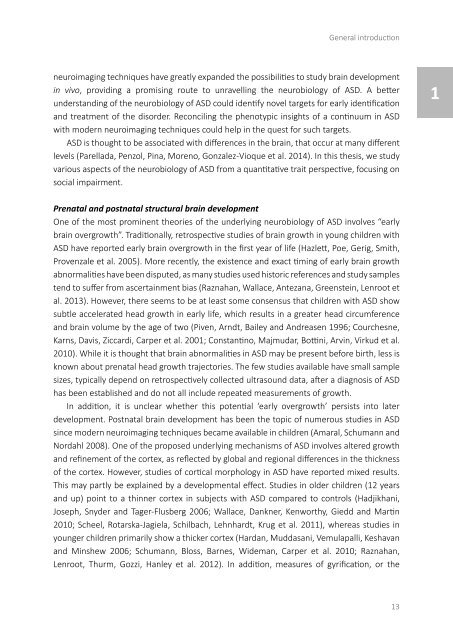On the Spectrum
2lm5UyR
2lm5UyR
Create successful ePaper yourself
Turn your PDF publications into a flip-book with our unique Google optimized e-Paper software.
General introduction<br />
neuroimaging techniques have greatly expanded <strong>the</strong> possibilities to study brain development<br />
in vivo, providing a promising route to unravelling <strong>the</strong> neurobiology of ASD. A better<br />
understanding of <strong>the</strong> neurobiology of ASD could identify novel targets for early identification<br />
and treatment of <strong>the</strong> disorder. Reconciling <strong>the</strong> phenotypic insights of a continuum in ASD<br />
with modern neuroimaging techniques could help in <strong>the</strong> quest for such targets.<br />
ASD is thought to be associated with differences in <strong>the</strong> brain, that occur at many different<br />
levels (Parellada, Penzol, Pina, Moreno, Gonzalez-Vioque et al. 2014). In this <strong>the</strong>sis, we study<br />
various aspects of <strong>the</strong> neurobiology of ASD from a quantitative trait perspective, focusing on<br />
social impairment.<br />
1<br />
Prenatal and postnatal structural brain development<br />
<strong>On</strong>e of <strong>the</strong> most prominent <strong>the</strong>ories of <strong>the</strong> underlying neurobiology of ASD involves “early<br />
brain overgrowth”. Traditionally, retrospective studies of brain growth in young children with<br />
ASD have reported early brain overgrowth in <strong>the</strong> first year of life (Hazlett, Poe, Gerig, Smith,<br />
Provenzale et al. 2005). More recently, <strong>the</strong> existence and exact timing of early brain growth<br />
abnormalities have been disputed, as many studies used historic references and study samples<br />
tend to suffer from ascertainment bias (Raznahan, Wallace, Antezana, Greenstein, Lenroot et<br />
al. 2013). However, <strong>the</strong>re seems to be at least some consensus that children with ASD show<br />
subtle accelerated head growth in early life, which results in a greater head circumference<br />
and brain volume by <strong>the</strong> age of two (Piven, Arndt, Bailey and Andreasen 1996; Courchesne,<br />
Karns, Davis, Ziccardi, Carper et al. 2001; Constantino, Majmudar, Bottini, Arvin, Virkud et al.<br />
2010). While it is thought that brain abnormalities in ASD may be present before birth, less is<br />
known about prenatal head growth trajectories. The few studies available have small sample<br />
sizes, typically depend on retrospectively collected ultrasound data, after a diagnosis of ASD<br />
has been established and do not all include repeated measurements of growth.<br />
In addition, it is unclear whe<strong>the</strong>r this potential ‘early overgrowth’ persists into later<br />
development. Postnatal brain development has been <strong>the</strong> topic of numerous studies in ASD<br />
since modern neuroimaging techniques became available in children (Amaral, Schumann and<br />
Nordahl 2008). <strong>On</strong>e of <strong>the</strong> proposed underlying mechanisms of ASD involves altered growth<br />
and refinement of <strong>the</strong> cortex, as reflected by global and regional differences in <strong>the</strong> thickness<br />
of <strong>the</strong> cortex. However, studies of cortical morphology in ASD have reported mixed results.<br />
This may partly be explained by a developmental effect. Studies in older children (12 years<br />
and up) point to a thinner cortex in subjects with ASD compared to controls (Hadjikhani,<br />
Joseph, Snyder and Tager-Flusberg 2006; Wallace, Dankner, Kenworthy, Giedd and Martin<br />
2010; Scheel, Rotarska-Jagiela, Schilbach, Lehnhardt, Krug et al. 2011), whereas studies in<br />
younger children primarily show a thicker cortex (Hardan, Muddasani, Vemulapalli, Keshavan<br />
and Minshew 2006; Schumann, Bloss, Barnes, Wideman, Carper et al. 2010; Raznahan,<br />
Lenroot, Thurm, Gozzi, Hanley et al. 2012). In addition, measures of gyrification, or <strong>the</strong><br />
13


